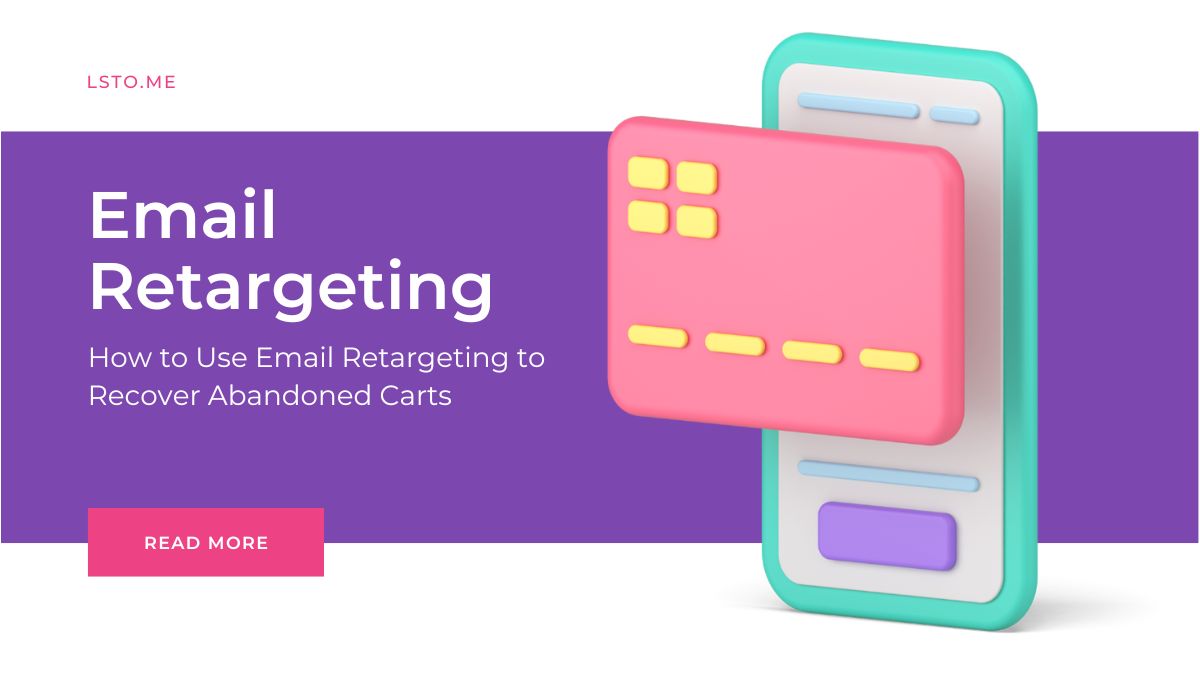
Abandoned carts are one of the biggest challenges for e-commerce businesses. Statistics show a 70% average cart abandonment rate. Most potential customers leave without completing their purchases. However, abandoned carts don’t have to mean lost sales. Email retargeting is a top way to recover lost opportunities and convert them.
This blog post will explore how email retargeting can help you. It can recover abandoned carts, boost sales, and improve customer retention. By the end of this guide, you’ll have actionable strategies to build an effective abandoned cart recovery campaign.
What is Email Retargeting?
Email retargeting is a type of personalized email marketing. It aims to re-engage visitors who took specific actions on your website but didn’t complete a desired goal, like a purchase. If customers abandon their carts, we send retargeting emails. They remind customers of the items left in their carts and urge them to complete their purchase.
These emails are triggered by user behavior. They can be highly personalized. This makes them more effective than standard promotional emails. The key goal of email retargeting is to nudge the customer to return to your site and finish the checkout process.
Why Do Shoppers Abandon Their Carts?
Before diving into strategies for email retargeting, it’s important to understand why shoppers abandon their carts in the first place. Common reasons include:
Unexpected costs: Additional fees like shipping, taxes, or handling can discourage customers from completing the purchase.
Complicated checkout process: Lengthy or confusing checkout forms can drive users away.
Concerns about payment security: Lack of trust in the payment methods can make customers hesitant to finalize the transaction.
Comparing prices: Some customers use the cart as a way to save items while they check for better deals elsewhere.
Lack of payment options: Limited or unavailable preferred payment methods can cause customers to abandon their carts.
Mobile experience: A poorly optimized mobile checkout experience can cause mobile users to leave before completing their purchase.
Knowing these pain points can help you design better retargeting strategies. They will address these specific reasons.
Benefits of Email Retargeting for Abandoned Carts
Email retargeting is a great way to recover lost sales. It has many benefits for e-commerce businesses.
Personalized communication: Email retargeting allows you to tailor messages to individual users based on their previous behavior and the items they left behind, making your outreach more relevant.
Increased conversions: According to studies, retargeted emails have a higher open rate and click-through rate compared to standard promotional emails. Customers are more likely to return to their cart after receiving a personalized reminder.
Cost-effective strategy: Compared to paid advertising retargeting, email retargeting is relatively inexpensive, yet yields significant returns on investment.
Opportunity for upselling and cross-selling: Cart abandonment emails can also suggest complementary products, encouraging customers to increase their order value.
Brand loyalty: Consistent and thoughtful communication with customers after they’ve shown purchase intent can help build trust and long-term loyalty.
How to Set Up an Effective Abandoned Cart Email Campaign
To recover abandoned carts effectively, it’s essential to set up a well-structured email retargeting campaign. Here’s a step-by-step guide on how to create a successful abandoned cart email campaign:
1. Set Up Triggers and Automated Workflows
The first step in email retargeting is to set up triggers that automatically send emails when a customer abandons their cart. Most e-commerce platforms, like Shopify and WooCommerce, offer tools or plugins to set up abandoned cart workflows.
For example:
If a user adds items to their cart and doesn’t complete the purchase within an hour, they should receive an email reminder.
If the user still hasn’t checked out after 24 hours, send a follow-up email.
2. Create a Series of Emails
Rather than sending just one reminder, it’s more effective to create a series of emails that gradually build urgency and offer incentives. A three-email sequence is commonly used:
Email 1: Friendly Reminder (1 Hour After Abandonment)
This email should be a simple reminder that the customer has left items in their cart. It should be personalized, include a photo of the items, and have a clear call-to-action (CTA) to return to checkout.
Email 2: Incentive or Urgency (24 Hours After Abandonment)
In this email, add a sense of urgency by mentioning that the items may sell out soon or are still waiting for them. Consider offering a discount or free shipping to entice the user to complete their purchase.
Email 3: Last Chance (48 Hours After Abandonment)
This email is the final push. It could mention that this is their last chance to purchase before the items are restocked or removed from their cart. If you’ve offered a discount, reiterate it here. You can also remind them of your return policies to alleviate concerns about purchasing.
3. Write Persuasive and Personalized Email Copy
Effective email copy is critical for converting abandoned cart customers. Here’s how to optimize your message:
Use the customer’s name in the subject line and body of the email.
Mention the product names or descriptions to remind them of the specific items they left behind.
Use urgency-based language, such as “limited stock,” “act now,” or “don’t miss out,” to create a sense of immediacy.
Highlight benefits and unique selling points of the product, like features, discounts, or customer reviews.
Include a strong CTA that directs the customer back to their cart. Use language like “Complete your purchase” or “Continue shopping.”
4. Offer Incentives
A great way to encourage customers to complete their purchase is by offering an incentive. Some common incentives include:
Discount codes: Offer a percentage or flat-rate discount on their purchase if they return to their cart within a certain time frame.
Free shipping: Shipping fees are a common reason for cart abandonment. Offering free shipping can motivate customers to follow through with their purchase.
Limited-time offers: Create urgency with limited-time deals, such as “10% off for the next 24 hours.”
5. Design Mobile-Friendly Emails
Since a large percentage of users shop on mobile devices, it’s crucial to ensure that your emails are mobile-friendly. Optimize your emails with:
Responsive design that adjusts to different screen sizes
Clear and clickable CTAs that are easy to tap on mobile devices
Concise text and visually appealing images that load quickly
6. Include Social Proof and Trust Signals
Customers may abandon their carts due to trust issues, such as uncertainty about product quality or concerns about returns. To address this, include social proof and trust signals in your emails:
Display customer reviews or testimonials for the products they left in their cart.
Mention free returns or money-back guarantees to reassure customers that they can shop risk-free.
Highlight security badges if the customer is concerned about payment safety.
7. Use A/B Testing to Optimize Your Campaign
To ensure that your abandoned cart email strategy is as effective as possible, use A/B testing to optimize your emails. Test different elements such as:
Subject lines
Email copy and tone
CTA buttons and placement
Timing of emails
Offers or discounts
Testing and analyzing performance data can identify the best variations. They will have the highest open, click-through, and conversion rates.
8. Segment Your Audience
Not all customers abandon their carts for the same reasons, so it’s important to segment your audience based on behavior and preferences. For example, customers who abandon high-ticket items may respond better to a discount. In contrast, those who abandon due to high shipping costs might prefer a free shipping offer.
Use your website data to create targeted campaigns. They should address the concerns and motivations of different customer groups.
Examples of Effective Abandoned Cart Emails
Here are a couple of examples that demonstrate best practices in abandoned cart email campaigns:
Example 1: Personalized Reminder with Product Image
Subject: “You Left Something Behind!” Body: “Hey [Customer Name], we noticed you left these items in your cart: [Product Image/Name]. They’re still available, but they won’t be for long! Complete your purchase now and enjoy free shipping.”
Example 2: Urgent Discount Offer
Subject: “Don’t Miss Out – 10% Off Just for You!” Body: “Hi [Customer Name], it looks like you’re still deciding on your purchase. To help you make up your mind, we’re offering you 10% off! Use code ‘SAVE10’ at checkout before midnight and save on your order.”
Conclusion
Abandoned carts are common in e-commerce. But, email retargeting can recover many lost sales. Use personalized, persuasive, and timely emails. They can guide potential customers back to their carts and encourage them to complete their purchases. From offering incentives to showing social proof, use the above strategies. They will help you create effective, high-converting abandoned cart emails.
The key to success is testing and optimization. You must refine your campaigns to improve performance and maximize recovery rates. You can turn abandoned carts into a profit and boost customer experience with the right approach.




